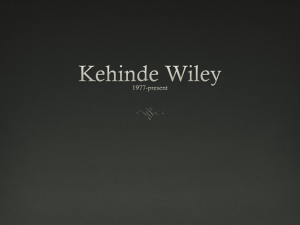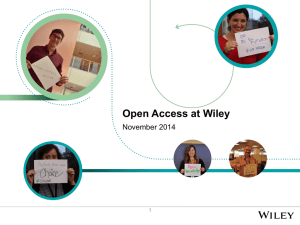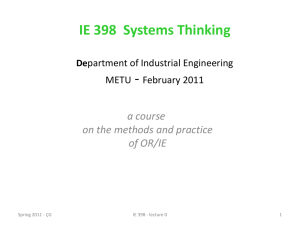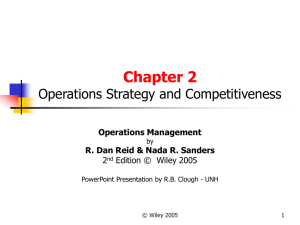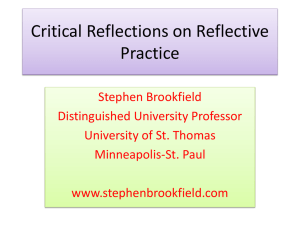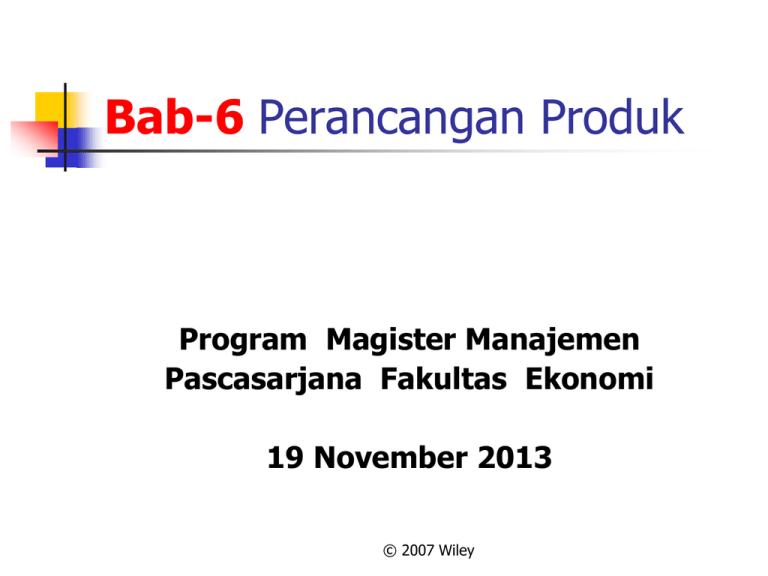
Bab-6 Perancangan Produk
Program Magister Manajemen
Pascasarjana Fakultas Ekonomi
19 November 2013
© 2007 Wiley
Tujuan Pembelajaran
Mendefinisikan perancangan produk
dan dampaknya terhadap organisasi.
Menjelaskan tahapan perancanan
produk
Menggunakan analisis break-even
analysis untuk memilih alternatif
Mengidentifikasi bentuk-bentuk yang
berbeda dan menjelaskan
karakteristiknya.
© 2007 Wiley
Tujuan, cont
Menggunakan flowchart
Menggunakan metriks kinerja
Memahami pengguaan teknologi dan
dampaknya terhadap pengembangan
produk.
Memahami isu yang berkaitan dengan
pengembangan produk.
© 2007 Wiley
Perancangan Produk
Product design – proses pendefinisian seluruh produk
dan karakteristik perusahaan. Harus diingat
Perancangan produk harus didukung oleh proses pabrik. (
(cara termudah dihasilkan di pabrik)
Perancangan produk dapat meliputi;
Appearance (pertampakan),
Materials (material),
Dimensions (dimensi),
Tolerances (toleransi), and
performance standards (standar keinerja)
© 2007 Wiley
Perancangan Jasa Vs Barang
Jasa sifatnya unik, sehingga perancangan
harus memenuhi:
Dirancang meliputi jasa dan konsep
- Unsur fisik, estetika, dan manfaat psikologis.
e.g. kecepatan, keakraban, atmosphere
Produk dan jasa dirancang harus memenuhi
kebutuhan dan preferensi kelompok pelanggan.
© 2007 Wiley
Akad Nikah Harus Bersusah-susah
http://www.kapanlagi.com/foto/beritafoto/indonesia/26074prosesi_akad_nik
ah_atiqah_hasiholan_dan_rio_dewant
o_di_pulau_kelor-20130826-011rita.html
© 2007 Wiley
Diskusikan Apa Makna Konsep
dalam Pernikahan?
© 2007 Wiley
Perancangan Produk dan Jasa
Perancangan produk dan proses
pemilihan mempengaruhi.
Kualitas produk
Biaya
Kepuasan pelanggan
Kemampuan pabrikasi dan kemudahan di
bidang operasi.
© 2007 Wiley
Proses Perancangan PRODUK
Step 1 – Pengembangan Ide
- Someone thinks of a need and a product/service design to satisfy it
e.g. customers, marketing, engineering, competitors,
benchmarking, reverse engineering
Step 2 – Pemeriksaan Perancangan
- Every business needs a formal/structured evaluation process
e.g. fit with facility and labor skills, size of market, contribution margin,
break-even analysis, return on sales
Step 3 – Perancangan awal dan pengujian
- Technical specifications are developed, prototypes built, testing starts
Step 4 – Rancangan Final
- Final design based on test results, facility, equipment, material, & labor
skills defined, suppliers identified
© 2007 Wiley
Menggunan Break-Even
Analysis
Computes the quantity of goods
company needs to sell to cover its costs
QBE = F/ (SP - VC)
QBE – Break even quantity
F – Fixed costs
SP – selling price/unit
VC – Variable cost
© 2007 Wiley
Product Screening Tool –
Break-Even Analysis
Break-even analysis also includes calculating
Total cost – sum of fixed and variable cost
Total cost = F + (VC)*Q
Revenue – amount of money brought in from
sales
Revenue = (SP) * Q
Q = number of units sold
© 2007 Wiley
Break-Even Analysis: Pendekatan Grafik
Compute quantity of goods that
must be sold to break-even
Compute total revenue at an
assumed selling price
Compute fixed cost and variable
cost for several quantities
Plot the total revenue line and
the total cost line
Intersection is break-even
Sensitivity analysis can be done
to examine changes in all of the
assumptions made
© 2007 Wiley
Break-even calculation: A company is planning to establish a chain of movie
theaters. It estimates that each new theater will cost approximately $1 Million. The
theaters will hold 500 people and will have 4 showings each day with average ticket
prices at $8. They estimate that concession sales will average $2 per patron. The
variable costs in labor and material are estimated to be $6 per patron. They will be
open 300 days each year. What must average occupancy be to break-even?
Break-Even Point
Total revenues = Total costs @ break-even point Q
Selling price*Q = Fixed cost + variable cost*Q
($8+$2)Q= $1,000,000 + $6*Q
Q = 250,000 patrons (42% occupancy)
What is the gross profit if they sell 300,000 tickets
Profit = Total Revenue – Total Costs
P = $10*300,000 – (1,000,000 + $6*300,000)
P = $200,000
If concessions only average $.50/patron, what is breakeven Q now? (sensitivity analysis)
($8.50)Q = 1,000,000 - $6*Q
Q = 400,000 patrons (67% occupancy)
© 2007 Wiley
Faktor yang berdampak pada
Perancangan Produk
Kebutuhan Perancangan Pabrik
Series of guidelines to
follow in order to produce
a product easily and
profitably
Minimilais bentuk produk
Standardisasi
Design parts for multiply
applications
Rancangan yang
terintegrasi
Sederhanakan operasi
© 2007 Wiley
Faktor Siklus Produk
Product life cycle –
series of changing
product demand
Consider product
life cycle stages
Introduction
Growth
Maturity
Decline
Facility & process
investment depends on
life cycle
© 2007 Wiley
Pabrikasi Simultan
Old “over-the –wall” sequential
design process should not be used
Each function did its work and passed it to
the next function
Replace with a Concurrent
Engineering process
All functions form a design team working
together to develop specifications, involve
customers early, solve potential problems,
reduce costs, & shorten time to market
© 2007 Wiley
Process Selection
Product design considerations must
include the process
Klasifikasi meliputi
Intermittent operations –
menghasilakan berbagai jenis dalam
jumlah kecil
Repetitive operations – menghasilakan
satu atau beberapa dalam jumlah
besar.
© 2007 Wiley
Process Selection
Lima Pertimbangan
Bentuk proses ; range from intermittent to
continuous
Derajat integrasi vertikal
Fleksibilitas sumberdaya
Bauran antara modal dan sumberdaya
manusia
Derajat kontak dengan konsumen
© 2007 Wiley
Process Selection
Process types can be: chika
Project process – make a one-at-a-time product
exactly to customer specifications
Batch process – small quantities of product in
groups or batches based on customer orders or
specifications
Line process – large quantities of a standard
product
Continuous process – very high volumes of a fully
standard product
Process types exist on a continuum
© 2007 Wiley
Underlying Process Relationship
Between Volume and Standardization
Continuum
© 2007 Wiley
Differences between Intermittent
and Continuous Operations
D ecision
Interm ittent O peration
C ontinuous O peration
Product variety
G reat
Sm all
D egree of standardization
Low
H igh
O rganization of resources
G rouped by Function
Line flow
Path of products
Varied, depends on product
Line flow
Factor driving production
Custom er orders
Forecast of dem and
Critical resource
Labor
Capital
Type of equipm ent
G eneral purpose
Specialized
D egree of autom ation
Low
H igh
Throughput tim e
Longer
Shorter
W ork-in-process inventory
M ore
© 2007 Wiley
Less
Designing Processes
Process design tools include
Process flow analysis
Process flowchart
Design considerations include
Make-to-stock strategy
Assemble-to-order strategy
Make-to-order strategy
© 2007 Wiley
Process Design Tools
Process flow analysis is
a tool used to analyze and
document the sequence of
steps within a total
process. Usually first step
in Process Reengineering.
Process Reengineering is a
structured approach
used when major
business changes are
required as a result of:
Major new products
Quality improvement
needed
Better competitors
Inadequate
performance
© 2007 Wiley
Facility Layout and Process Choice
© 2007 Wiley
Process Performance Metrics
Determining if a process is functioning
properly is required
Determination requires measuring
performance
Process performance metrics –
measurement of different process
characteristics that tell us how a process is
performing
© 2007 Wiley
Process Performance Metrics
© 2007 Wiley
Linking Product Design &
Process Selection
Product design and process selection directly
linked
Type of product selected defines type of
operation required
Type of operation available defines broader
organizational aspects such as
Equipment required
Facility arrangement
Organizational structure
© 2007 Wiley
Linking Design & Process Selection
Organizational Decisions appropriate for different types of operations
© 2007 Wiley
Intermittent VS. Repetitive Layouts
© 2007 Wiley
Product and Service Strategy
Type of operation is directly related to
product and service strategy
Three basic strategies include
Make-to-stock; in anticipation of demand
Assemble-to-order; built from standard
components on order
Make-to-order; produce to customer
specification at time of order
© 2007 Wiley
Product and Service Strategy Options
© 2007 Wiley
Process Decisions-Vertical Integration
& Make or Buy
Vertical integration refers to the degree a firm chooses to do
processes itself- raw material to sales
Backward Integration means moving closer to primary operations
Forward Integration means moving closer to customers
A firm’s Make-or-Buy choices should be based on the following
considerations:
Strategic impact
Available capacity
Expertise
Quality considerations
Speed
Cost (fixed cost + variable cost)make = Cost (fixed cost + Variable cost)buy
Business are trending toward less backward integration, more
outsourcing
© 2007 Wiley
Manufacturing Technology Decisions
Simplify first then apply appropriate technology
Information Technology: ERP, GPS, RFID
Automation
Automated Material Handling:
Automated guided vehicles (AGV)
Automated storage & retrieval systems (AS/RS)
Flexible Manufacturing Systems (FMS)
Robotics & Numerically-Controlled (NC) equipment
© 2007 Wiley
E-manufacturing
Web-based environment creates numerous
business opportunities to include;
Product design collaboration
Process design collaboration
Computer-aided design – uses computer
graphics to design new products
Computer-integrated manufacturing –
integration of product design, process
planning, and manufacturing using an
integrated computer system
© 2007 Wiley
How Are Services Different
from Manufacturing
Services are different from
manufacturing as they;
Produce intangible products
Involve a high degree of customer contact
Type of service is classified according to
degree of customer contact
© 2007 Wiley
Designing Services
Service Characteristics
Pure services
Quasi-Manufacturing
Mixed services
Service Package
The physical goods
The sensual benefits
The psychological benefits
Differing designs
Substitute technology for
people
Get customer involved
High customer attention
© 2007 Wiley
Product Design and Process
Selection Across the Organization
Strategic and financial of product design
and process selection mandates
operations work closely across the
organization
Marketing is impacted by product that is
produced
Finance is integral to the product design
and process selection issues due to
frequent large financial outlays
© 2007 Wiley
Product Design and Process Selection
Across the Organization - continued
Strategic and financial of product design and
process selection mandates operations work
closely across the organization
Information services has to be developed to match
the needs of the production process
Human resources provides important input to the
process selection decisions for staffing needs
© 2007 Wiley
Chapter 3 Highlights
Product design is the process of deciding on the unique
characteristics and features of a company’s product
Process selection is the development of the process
necessary to produce the product being designed.
Steps in product include idea generation, product
screening, preliminary design and testing, and final design
Break-even analysis is a tool used to compute the amount
of goods that have to be sold just to cover costs.
Production processes can be divided into two broad
categories: intermittent and repetitive operation project to
batch to line to continuous
© 2007 Wiley
Chapter 3 Highlights
Product design and process selection decisions are
linked
Process flow charts is used for viewing the flow of
the processes involved in producing the
Different types of technologies can significantly
enhance product and process design. These include
automation, automated material handling devices,
CAD, NC, FMS, and CIM
Designing services have more complexities than
manufacturing, because service produce an
intangible product and typically have a high degree
of customer contact.
© 2007 Wiley
The End
Copyright © 2007 John Wiley & Sons, Inc. All rights reserved.
Reproduction or translation of this work beyond that permitted
in Section 117 of the 1976 United State Copyright Act without
the express written permission of the copyright owner is
unlawful. Request for further information should be addressed
to the Permissions Department, John Wiley & Sons, Inc. The
purchaser may make back-up copies for his/her own use only
and not for distribution or resale. The Publisher assumes no
responsibility for errors, omissions, or damages, caused by the
use of these programs or from the use of the information
contained herein.
© 2007 Wiley


